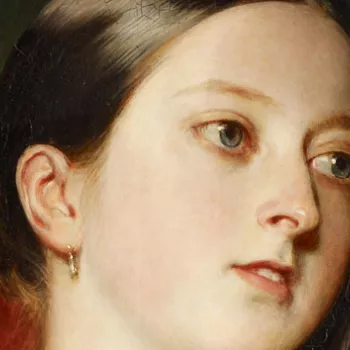Ramsgate Sands (Life at the Seaside) 1851-54
Oil on canvas | 77.0 x 155.1 cm (support, canvas/panel/stretcher external) | RCIN 405068
-
Ramsgate, a seaside resort on the Kentish coast, became accessible for day trips from London in the 1840s as a result of the development of the railways. In Frith's picture children building sandcastles and fashionably dressed young ladies appear alongside street entertainers, a troupe of 'blackface' minstrels and tradesmen, all rendered in exceptional detail. Having earlier painted 'costume pieces' illustrating scenes from history or literature, Frith was one of the first artists to paint such scenes of modern life – a shift which anticipates the work of the Impressionists during the 1870s and 1880s.
Frith spent the summer of 1851 at Ramsgate and it was then that he conceived of the idea for the painting, making preparatory sketches. An oil sketch (Dunedin, Public Art Gallery) is very close in composition to the final picture, the main changes being to the group of figures in the right-hand corner. In the final work the artist introduced a self-portrait into this group – his face is just visible behind the elderly lady who bends down to comfort a frightened child. In fact the artist's viewpoint must have been from the shallows of the water. The young child being tempted into the water by her mother, left of centre, is one of the most captivating characters. She was said to be the artist's daughter, and the object of her gaze was therefore her father (The New Monthly Belle Assemblée, June 1854, p. 331). The inclusion of a group of minstrels in ‘blackface’ illustrates just how common this form of entertainment was in the Victorian period. There are reports of troupes performing along the south coast in the late 1840s, however, the performances reinforced negative racial stereotypes of Black people and today are considered highly derogatory.
Ramsgate Sands proved a great success with the public. Its reception at the Royal Academy in 1854 was so enthusiastic that a guard-rail was installed to protect it from the crowds keen to examine the details at close hand. Like the popular novels of Dickens (see especially his account of 'The Tuggses at Ramsgate' in Sketches by Boz, 1836), the painting was intended to be 'read', the viewer's eye being drawn across the painting to the various different interlocking episodes and characters. The picture was also well received by the critics, who praised the artist for depicting the world around him and for the variety of the characters. The Art Journal rightly predicted that Ramsgate Sands would become valuable 'as a memento of the habits and manners of the English "at the seaside" in the middle of the nineteenth century' (Art Journal, June 1854, p.161).
Upon seeing the painting at the Royal Academy exhibition of 1854 Queen Victoria expressed an interest in buying it, but it had already been sold to the dealers Messrs Lloyd for £1000. Frith wrote: 'Eastlake presented me to the Queen. She was delighted with Seaside. Wanted to buy it – found she couldn't, and gave me a commission for a similar subject' (Frith 1889, p.172). This royal commission was abandoned however when the purchasers agreed to sell the picture on for the original price, upon the condition that they be allowed to borrow it for engraving and retain rights to the profits from the resulting print – a highly lucrative business decision.
Queen Victoria had visited Ramsgate several times with her mother between 1825 and 1836 and had stayed in Albion House, visible in Frith's composition as the highest building overlooking the beach. Her memories of the seaside town and knowledge of the area no doubt awoke her interest in a painting which depicted familiar landmarks with great accuracy. She had recent experience at Osborne of 'bathing machines' – contraptions which carried a swimmer into the water in privacy – such as those on the far right of Ramsgate Sands. She wrote in July 1847: 'drove down to the beach with my maid & went into the bathing machines, where I undressed & bathed in the sea (for the 1st time in my life), a very nice bathing woman attending me. I thought it delightful till I put my head under the water, when I thought I should be stifled' (Journal, 30 July, 1847).
In 1857 Frith was asked by the royal couple to paint the marriage of the Princess Royal but he declined owing to the need to finish another of his most famous scenes of modern life, Derby Day (London, Tate). The Queen and Prince Albert saw that picture at the Royal Academy in 1858 and discussed it with the artist. As a result of this conversation, Frith wrote, 'I put many of the Prince's suggestions to the proof after the close of the Exhibition, and I improved my picture in every instance' (Frith 1889, p.192). This echoes the comments of John Martin (RCIN 403602) and Joseph Noël Paton (RCIN 406954), both of whom also valued Prince Albert's advice on their work and made changes accordingly. Frith was later to paint for Queen Victoria the Marriage of the Prince of Wales (1863, RCIN 404545).
Inscribed on the back with the title (Life at the Sea side) and the name of the artist
Text adapted from Victoria & Albert: Art & Love, London, 2010Provenance
Purchased by Queen Victoria from Messrs Lloyd (payment dated 13 July 1854, £1,000, QV Ledgers 1854/90)
-
Creator(s)
Acquirer(s)
-
Medium and techniques
Oil on canvas
Measurements
77.0 x 155.1 cm (support, canvas/panel/stretcher external)
112.1 x 188.3 x 12.4 cm (frame, external)
Category
Object type(s)









